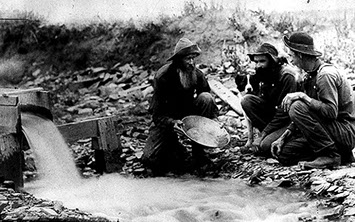





Black Hills Gold Rush
Gold rush into the Black Hills of the Dakota Territory, precipitated the Black Hills Expedition's discovery of gold in the summer of 1874.[1]
The Black Hills were located mostly on the Great Sioux Reservation, ceded to the Sioux in perpetuity by the 1868 Treaty of Fort Laramie, which forbade white men from entering and usurping Indian lands. But Lieutenant Colonel George Armstrong Custer's report of gold in the Black Hills hit the country in August of 1874, at the height of the economic depression caused by the Panic of 1873.[1] The U. S. Army tried in vain to protect the Indian lands and chase prospectors out of the region.[2]
Stage West: In June of 1875,[3] Sam Harris stuck a pocket of free gold[4] along the northeast rim[3] of the Black Hills. Knowing it was on Indian land, he and his partner, Matson, tried to keep the strike secret.[4] But in July,[3] Wes Fallon fatally shot Harris, trying to get him to reveal the location of the mine and left him for dead. Before Harris died, Bret Maverick found and tried to help Harris. In gratitude, Harris showed Bret the location of the mine. When a band of Sioux discovered Bret was taking gold nuggets out of their land, the gave chase with the intent of killing him in retribution for his theft and trespassing. Bret managed to escape, crossing out of the Sioux land and reaching Packsaddle Station in safety. He had drawn a map to the Harris Mine and sold it to Mart Fallon for $15,000. When Simmons told the sheriff of Twin Bluffs that Bret had sold Fallon a mine on Indian land, the sheriff confronted Bret. But Bret explained he hadn't sold a mine on Indian land. He had only sold a map, which he knew to be worthless.[4]
The white intrusions into the Black Hills were too numerous for the Army to enforce the treaty with the Sioux. By the time the rush of gold-seekers discovered more rich deposits near the future town of Lead in April of 1876, the mining camp of Deadwood had been founded. By May, its saloons, gaming halls, brothels and other businesses were growing rapidly.[5]
Deeply angered at the escalating encroachment of white fortune-seekers, the Sioux retaliated in an attempt to keep their promised lands and drive the intruders out, sparking the Great Sioux War of 1876 and the Battle of Little Bighorn that June.[6]
In retribution to the Sioux's massacre of the U. S. Army's 7th Cavalry at Little Bighorn, and wishing to reclaim the rich resources of the Black Hills, the U. S. Government took back large portions of the Great Sioux Reservation with the Act of February 28, 1877, thus opening the lands to white settlement, prospecting and homesteading.[7]
Stampede: Bret Maverick's introduction to his story referred to the 1875 discovery of gold in the Black Hills starting "a great stampede of gold-hungry men."[8] However, the discovery leading to the Black Hills Gold Rush was made in the summer of 1874.[1] Bret's reference was probably to the 1875 discovery of gold in Deadwood Gulch, where he was headed in 1877, the time of his story.[3]
SOURCE REFERENCES
01. Gold in the Black Hills (January 1966), Watson Parker; University of Oklahoma Press
02. Fort Pierre-Deadwood Trail: Route to the Gold Fields of the Black Hills (1989); Delwin Jensen; The State Publishing Company
03. The Conjectural Maverick, Maverick Trails
04. Maverick, Stage West (1957), Warner Bros. Pictures, Inc.
05. The Struggle for the Black Hills; Overblog (retrieved July 2, 2015)
06. Lakota and Cheyenne: Indian Views of the Great Sioux War, 1876–1877 (April 15, 2000); Jerome A. Greene; University of Oklahoma Press
07. Act of February 28, 1877; 44th Congress (retrieved June 27, 2015)
08. Maverick, Stampede (1957), Warner Bros. Pictures, Inc.
Early placer mining in the Black Hills.[3]
Bret Maverick's map to the Harris Mine in the Black Hills,[4] July 1875.[3]
Bret Maverick plays poker in the salon of the Dakota Queen, bound up the Missouri River[8] to the Fort Pierre-Deadwood Trail, April 1877.[3]



Home | The Maverick Saga | Trail Maps | Chronology | Maverick Lore | Production | The Inside Straight | Contact Maverick Trails
Maverick Trails is not endorsed, sponsored or affiliated with Warner Bros. Entertainment, Inc. or the Maverick franchise.
Maverick™ and its various marks are trademarks of Warner Bros. Entertainment, Inc., © 1957, 1994
©2014, 2015, 2016 Maverick Trails

